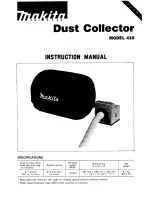
3
oneida-air.com
System Start-Up Information (Continued)
codes and regulations when installing and operating this dust collector.
b. Before Purchasing or Installing a dust collection system the buyer is cautioned to do so in accordance with prescribed
Federal, State, Local, OSHA, NFPA, and any other applicable codes or regulations relating to the type of dust(s) you are
collecting.
c. Most local jurisdictions consult or adopt NFPA (National Fire Protection Agency) codes. However, other codes may
apply. Local codes may vary from jurisdiction to jurisdiction.
d. NFPA664 Code book, “Standard for the Prevention of Fires and Explosions in Wood Processing and Woodworking
Facilities”, applies to woodworking operations that occupy areas of more than 5,000 sq. ft. or to areas where dust
producing equipment requires an aggregate dust collection flow rate of more than 1,500 cfm (cubic feet per minute).
This exempts some small operators from the NFPA code 664, but other codes may apply in your jurisdiction. Consult
your local Fire Marshal for help. Additional information can be found in NFPA Code Book 664.
4. DO NOT use this product to collect other types of flammable dust or flammable vapors! - Fire or explosion may occur!
5. NEVER collect sparks from a bench grinder into a wood dust collector.
6. NEVER introduce sparks or sources of ignition into the dust collector.
7. Check dust bin frequently for smoldering material and before leaving the shop.
8. Keep portable fire extinguishers handy.
a. The ABC type (dry chemical) is generally a good choice for small wood shops.
b. Additional information on portable extinguishers can be found in NFPA 10 (Standard for Portable Fire Extinguishers).
9. Be especially careful with sanding units. They can produce concentrations of dust in the combustible range. Make certain
enough air volume is at the suction point to capture all the particulate generated.
10. This high air volume will dilute the mixture below the lower limit of flammability. Be careful not to generate sparks into the
sanding dust.
11. Some dust created by power sanding, sawing, grinding, drilling, and other construction activities contains chemicals
known to cause cancer, birth defects or other reproductive harm. Your risk from these exposures varies, depending on how
often you do this type of work. To reduce your exposure to these chemicals, work in a well-ventilated area, and work with
approved safety equipment, such as those dust masks that are specially designed to filter out microscopic particles. Oneida
Air Systems recommends using additional approved safety equipment such as an approved OSHA and NIOSH dust mask or
respirator. Some examples of these chemicals are:
a. Lead from lead-based paints.
b. Crystalline silica from bricks, cement and other masonry products.
c. Arsenic and chromium from chemically-treated lumber.
12. DO NOT overload woodworking equipment, especially sanders. Excessive frictional heat can spontaneously ignite dust.
13. Empty dust bin and clean filter often, especially when sanding.
14. DO NOT allow accumulation of layers of fine dust on horizontal surfaces (especially overhead lights, electrical boxes and
fuse panels which can ignite dust.)
15. UNPLUG UNIT BEFORE SERVICING, REMOVING BLOCKAGES, OR CLEANING.
Customer Service Dept.
1-866-387-8822 • support@oneida-air.com
































